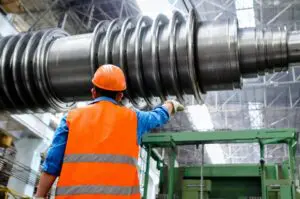Most Common Manufacturing Injuries
Manufacturing industry jobs are essential to our economy, as the sector keeps other businesses running. According to the U.S. Bureau of Labor Statistics, approximately 12,083,479 people were employed in the private manufacturing sector as of 2020. However, manufacturing factory workers are at a higher risk of workplace injuries due to the potential hazards of the work. Manufacturing jobs often involve operating heavy machinery, frequent heavy lifting, the risk of falling objects, repetitive tasks, and exposure to harmful substances.
 Some of the most common workplace injuries include repetitive stress injuries, overexertion injuries, developing musculoskeletal disorders, hearing loss from exposure to loud machinery, burns, slip and fall accidents, and serious injuries from falling objects. Manufacturing facilities must prioritize workplace safety, follow established safety protocol guidelines to protect workers from injury, and provide comprehensive training for employees.
Some of the most common workplace injuries include repetitive stress injuries, overexertion injuries, developing musculoskeletal disorders, hearing loss from exposure to loud machinery, burns, slip and fall accidents, and serious injuries from falling objects. Manufacturing facilities must prioritize workplace safety, follow established safety protocol guidelines to protect workers from injury, and provide comprehensive training for employees.
Machinery-Related Injuries
Machinery-related injuries are common in the manufacturing industry. Factory workers may sustain injuries due to faulty equipment, lack of proper training, failure to wear personal protective equipment, improper movement of heavy equipment, failure to heed warning signs, and failure to follow established safety protocols.
Mechanical equipment interaction risks include the following:
- Complex Machinery Hazards: complex machinery poses potential hazards to workers, including exposure to loud machinery and hazardous chemicals, electrical hazards, and equipment malfunction that can result in injury
- Equipment Entanglement Dangers: factory workers are at risk of having their clothing, hair, jewelry, or other items become entangled in the machinery or equipment
- Moving Parts and Amputation Risks: Machinery’s moving parts pose the risk of serious injuries. The worker’s body parts and clothing can become caught in the machine while it is operating, resulting in the loss of limbs or other injuries.
Contact a workers’ compensation lawyer at Munley Law if you have suffered a machinery-related injury.
Slip and Fall Injuries
 Slip-and-fall injuries are among the most common workplace injuries in manufacturing facilities due to the sheer volume and speed of activity, wet floors from spills, clutter on floors and work surfaces, poor lighting, and improper enforcement of workplace safety protocols.
Slip-and-fall injuries are among the most common workplace injuries in manufacturing facilities due to the sheer volume and speed of activity, wet floors from spills, clutter on floors and work surfaces, poor lighting, and improper enforcement of workplace safety protocols.
Common slip and fall injuries include the following:
- Broken bones, head trauma, back injuries: Slip and fall accidents in a manufacturing facility may result in broken bones, head trauma, contusions, concussion, back pain, sprains, fractures, and soft tissue damage
- Wet and Uneven Flooring and Surfaces: Wet, oily floors are slick, hazardous areas for workers and put workers at higher risk of slipping. Uneven flooring in factories and wearing inappropriate footwear put factory workers at higher risk of slip and fall injury
- Obstacles and Cluttered Work Spaces: When manufacturing facilities have exposed wires, tools that are left out on the floor, and materials and clutter left in work spaces, this environment puts manufacturing workers at greater risk of injury
Encourage employees to adopt a safer workplace by making sure they are properly trained in the use of equipment and following established safety guidelines.
Overexertion and Repetitive Stress Injuries
Overexertion and repetitive stress injuries are common workplace injuries in manufacturing facilities, which are the result of:
- Lifting and Handling Heavy Loads: Lifting heavy objects without proper form can result in overexertion and back strain
- Repetitive Motion Damage: Performing repetitive tasks daily can result in repetitive motion injuries, such as carpal tunnel syndrome
- Ergonomic Workplace Limitations: Standing for long periods, incorrect positioning of chairs and desk height, and poorly lit workspaces can lead to back, leg, and neck pain, strained eyesight, headaches, and vision problems
Use proper lifting techniques and request ergonomic job assessments.
Chemical and Toxic Exposure Injuries
Chemical and toxic exposure injuries occur when workers are in contact with harmful substances, which can result in burns, skin irritation, respiratory issues, and even death, depending upon the type of hazardous chemicals involved. Some important factors to consider include:
- Chemical Interaction Dangers: Potential hazards include interaction with pesticides, asbestos, lead, benzene, mercury, bleach, ammonia, carbon monoxide, chlorine, and other industrial and household chemicals
- Toxic Material Handling: Direct contact with a toxic material through inhalation, skin contact, or ingestion can result in acute injuries such as skin irritation, blistering, burns, eye irritation, coughing, dizziness, vomiting, and respiratory distress
- Long-Term Health Implications: Long-term health implications of exposure to harmful substances include cancer, reproductive issues, organ damage, respiratory issues, and other injuries
Follow strict safety protocols and use comprehensive protective equipment when handling hazardous chemicals and flammable materials.
Falling Object Injuries
Falling object injuries are common in the manufacturing industry, where heavy objects such as tools, materials, and equipment are situated on elevated surfaces. Common conditions contributing to falling object injuries include:
- Unsecured Materials: A failure to properly secure materials leads to falling object injuries when workers are struck by tools, wires, parts, and equipment
- Improper Storage Practices: A failure to follow guidelines for proper storage of tools and materials leads to falling objects and puts workers at risk
- Warehouse and Storage Area Dangers: Improperly stored items, including flammable materials, chemicals, machinery, and equipment, and a lack of warning signs regarding the types of materials being stored puts workers at risk of injury
Wear hard hats and ensure proper material storage techniques to help prevent falling object injuries.
Burn and Fire-Related Injuries
Burn and fire-related injuries frequently occur in manufacturing environments, where employees regularly handle flammable materials and work with machines that operate at high temperatures. The following conditions can lead to burn and fire-related injuries:
- Fire Hazards: Flammable liquids, gases, faulty electrical equipment, overheating machines, combustible dust, and sparks from operating machinery pose a safety hazard for workers
- Explosive Material Interactions: Contact with explosive materials such as igniters, fuse lighters, safety fuses, and black powder can lead to burn and fire-related injuries
- Thermal and Chemical Burn Hazards: Workers are at high risk due to the regular exposure to and use of hot machinery and equipment, steam, hot liquids, corrosive chemicals and solvents, and reactive chemicals and vapors
Wear appropriate personal protective equipment (PPE) and complete comprehensive training on equipment use and safety protocols.
Vehicle and Transportation-Related Injuries
Vehicle and transportation-related injuries are common for factory workers as many factories operate industrial vehicles.
- Forklift Accidents: The U.S. Bureau of Labor Statistics reports that from 2011 to 2017, there were 614 fatalities in forklift accidents and more than 7,000 nonfatal injuries sustained by workers
- Vehicle Crashes: Vehicle accidents involving forklifts, mobile machinery, and transportation carts are common due to improper use of the vehicle, operator error, equipment malfunction, and crowded workspaces
- Loading and Unloading Challenges: Not following proper lifting techniques and moving heavy machinery poses safety concerns for workers
Prioritize workplace safety. Make sure you are properly trained in using equipment and follow National Safety Council guidelines to ensure a safer workplace for yourself and others.
Hearing and Vision Loss Injuries
Manufacturing employees are at a higher risk of hearing loss due to exposure to high-volume machinery and a greater risk of eye injuries due to flying objects.
- Noise-Induced Hearing Loss: The U.S. Centers for Disease Control and Prevention (CDC) reports that approximately 18% of all manufacturing employees have hearing difficulty, with 28% of workers exposed to loud noises reporting that they did not wear hearing protection
- Eye Injury Potential: Cutting, grinding, spraying, sanding, welding and other manufacturing activities put workers at a higher risk for eye injury and vision loss due to airborne debris, chemical splashes, and small particles that enter the eye
- Sensory Protection Challenges: Protecting workers from common sensory hazards requires the use of personal protective equipment (PPE) such as earplugs, safety glasses, masks, and clothing specifically designed to withstand certain temperatures
Protect your safety and well-being by following all guidelines for workplace safety.
Legal Protections and Recovery
 Legal protections and recovery are available to workers injured in manufacturing accidents:
Legal protections and recovery are available to workers injured in manufacturing accidents:
- Workers’ Compensation Claims: A manufacturing employee may receive workers’ compensation benefits to cover the cost of medical care and recover any lost wages
- Disability Benefits: Disability benefits may be available for a manufacturing employee who is permanently or temporarily disabled by a workplace injury and unable to perform their job duties or return to work
- Third-Party Claims: Third-party claims allow workers to seek additional compensation for their injuries from someone other than their employer. Third-party entities must have displayed negligence that caused or contributed to the accident and may include equipment manufacturers or contractors
Consult with a legal professional to understand your rights and the potential compensation you may recover for your workplace injuries. Munley Law offers a free consultation and evaluation of the merits of your claim.
Posted in Workers' Compensation.
Tagged Claim Concussion Hazard Loss Motion Negligence Request Slip and Fall









